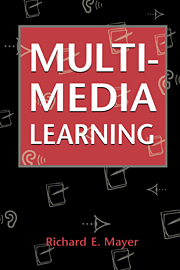Book contents
- Frontmatter
- Contents
- PREFACE
- 1 The Promise of Multimedia Learning
- 2 Multimedia Instructional Messages
- 3 A Cognitive Theory of Multimedia Learning
- 4 Multimedia Principle
- 5 Spatial Contiguity Principle
- 6 Temporal Contiguity Principle
- 7 Coherence Principle
- 8 Modality Principle
- 9 Redundancy Principle
- 10 Individual Differences Principle
- 11 Principles of Multimedia Design
- REFERENCES
- AUTHOR INDEX
- SUBJECT INDEX
5 - Spatial Contiguity Principle
- Frontmatter
- Contents
- PREFACE
- 1 The Promise of Multimedia Learning
- 2 Multimedia Instructional Messages
- 3 A Cognitive Theory of Multimedia Learning
- 4 Multimedia Principle
- 5 Spatial Contiguity Principle
- 6 Temporal Contiguity Principle
- 7 Coherence Principle
- 8 Modality Principle
- 9 Redundancy Principle
- 10 Individual Differences Principle
- 11 Principles of Multimedia Design
- REFERENCES
- AUTHOR INDEX
- SUBJECT INDEX
Summary
Spatial Contiguity Principle: Students learn better when corresponding words and pictures are presented near rather than far from each other on the page or screen.
Theoretical Rationale: When corresponding words and pictures are near each other on the page or screen, learners do not have to use cognitive resources to visually search the page or screen and learners are more likely to be able to hold them both in working memory at the same time. When corresponding words and pictures are far from each other on the page or screen, learners have to use cognitive resources to visually search the page or screen for corresponding words and pictures. Thus, learners are less likely to be able to hold them both in working memory at the same time.
Empirical Rationale: In two of two tests, learners performed better on retention tests when corresponding text and illustrations were placed near each other on the page (or when corresponding on-screen text and animation segments were placed near each other on the screen) than when they were placed far away from each other. In five of five tests, learners performed better on transfer tests when corresponding text and illustrations were placed near each other on the page (or when corresponding on-screen text and animation segments were placed near each other on the screen) than when they were placed far away from each other.
INTRODUCTION
Space as an Economic Resource
When it comes to presenting multimedia material – words and pictures – on a computer screen or textbook page, the amount of available space is limited.
- Type
- Chapter
- Information
- Multimedia Learning , pp. 81 - 95Publisher: Cambridge University PressPrint publication year: 2001
- 1
- Cited by



